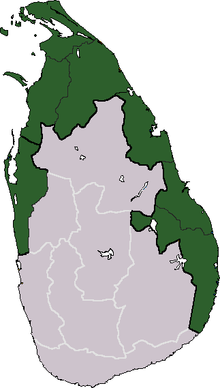
Back Guerre de l'Eelam IV French Չորրորդ իսլամական պատերազմ Armenian Четвёртая Иламская война Russian උතුර සහ නැගෙනහිර මුදාගැනීමේ මානුෂීය මෙහෙයුම් Singhalese நான்காம் ஈழப்போர் Tamil
| Eelam War IV | |||||||
|---|---|---|---|---|---|---|---|
| Part of the Sri Lankan Civil War | |||||||
 The area of Sri Lanka claimed by the LTTE as Tamil Eelam, where the vast majority of the fighting took place | |||||||
| |||||||
| Belligerents | |||||||
|
| ||||||
| Commanders and leaders | |||||||
|
Mahinda Rajapaksa Sarath Fonseka Wasantha Karannagoda Roshan Goonatilake | Velupillai Prabhakaran † | ||||||
| Strength | |||||||
| 200,000 (approx.) | 30,000 (approx.) | ||||||
| Casualties and losses | |||||||
|
6,261 killed[3] (government claim[4][5]) 29,551 wounded (government claim[4][5]) |
22,000 killed 8,000 captured (government claim[4][5]) | ||||||
Eelam War IV is the name given to the fourth and final phase of armed conflict between the Sri Lankan military and the separatist Liberation Tigers of Tamil Eelam (LTTE). Renewed hostilities began on the 26 July 2006, when Sri Lanka Air Force fighter jets bombed several LTTE camps around Mavil Aru anicut. The government's casus belli was that the LTTE had cut off the water supply to surrounding paddy fields in the area. Shutting down the sluice gates of the Mavil Aru on July 21 depriving the water to over 15,000 people - Sinhalese and Muslim settlers under Sri Lankan state-sponsored colonisation schemes in Trincomalee district. They were denied of water for drinking and also cultivating over 30,000 acres of paddy and other crops. The fighting resumed after a four-year ceasefire between the Government of Sri Lanka (GoSL) and LTTE. Continued fighting led to several territorial gains for the Sri Lankan Army, including the capture of Sampur, Vakarai and other parts of the east. The war took on an added dimension when the LTTE Air Tigers bombed Katunayake airbase on March 26, 2007, the first terrorist air attack without external assistance in history.
Eelam War IV ended on 18 May 2009 with the Sri Lanka Army gaining control of the last bit of territory held by the LTTE and with the death of the LTTE leader Velupillai Prabhakaran. The final few days of the war near Nandikadal Lagoon in the north east of the island saw very heavy fighting and led to Sri Lankan forces being accused of war crimes, which were denied by the government. Some 300,000 Tamil civilians who were trapped inside the war zone and prevented from escaping by the LTTE were caught in the crossfire during the final phase of the war.
- ^ "Pakistan played a key role in LTTE defeat".
- ^ "Pakistan airforce pilots played key role in Sri Lankan victory".
- ^ "LankaWeb – ERASING THE EELAM VICTORY Part 14 E".
- ^ a b c "Sri Lanka reveals battle losses". english.aljazeera.net.
- ^ a b c "Sri Lankan army deaths revealed". BBC News. 2009-05-22. Retrieved 2010-05-01.